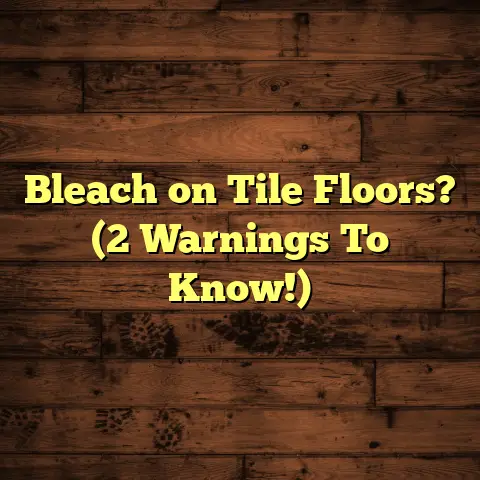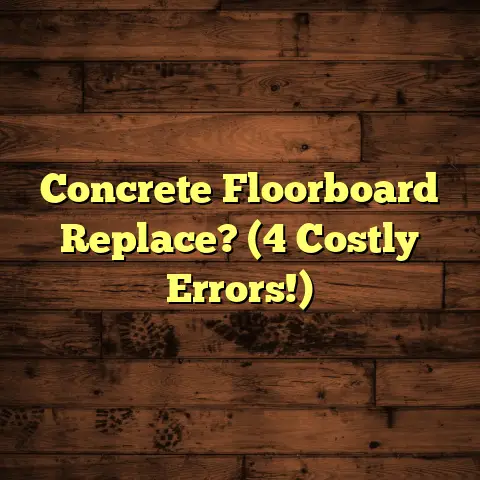Silicone Paper Under Hardwood? (3 Mistakes to Avoid!)
Imagine stepping into your beautifully finished home, the hardwood floors gleaming under the light, exuding elegance and sophistication.
But wait—what if beneath that polished surface lies a hidden layer of silicone paper that could spell disaster for your investment?
As renovations become more popular and DIY projects soar, many homeowners are turning to unconventional methods for laying hardwood floors.
But before you roll out that silicone paper, let’s explore the potential pitfalls that could jeopardize your flooring endeavor.
In the world of home improvement, every decision counts.
The choice of materials, installation methods, and even underlayment can significantly impact the longevity and performance of hardwood floors.
One such material that has gained attention is silicone paper.
But is it really the miracle solution some claim it to be?
In this article, I will delve into the top three mistakes that homeowners often make when considering silicone paper as an underlayment for hardwood flooring.
As a flooring contractor with over 15 years under my belt, I’ve seen it all.
Trust me, you want to avoid these headaches.
By understanding these missteps, you can ensure a successful flooring project that stands the test of time.
Section 1: Mistake #1 – Ignoring Moisture Control
Subheading: The Silent Enemy: Moisture
Moisture. It’s the bane of every flooring contractor’s existence.
And believe me, it’s something you absolutely CANNOT ignore when installing hardwood.
Why? Because wood is a hygroscopic material, meaning it naturally absorbs and releases moisture from its environment.
Think of it like a sponge.
Now, where does silicone paper fit into all this?
Well, it can act as a vapor barrier, which sounds good in theory.
But here’s the kicker: it’s not breathable.
This means that if moisture does get trapped underneath the silicone paper (and trust me, it often does), it has nowhere to escape.
The result?
Warping, buckling, and even mold growth.
And let me tell you, mold remediation is NOT a fun or inexpensive project.
I remember one job in particular, a beautiful Victorian home in San Francisco.
The homeowner, bless her heart, had tried to save some money by using silicone paper under her brand-new oak floors.
Within six months, the floors started to cup and buckle.
When we pulled them up, we found a thriving colony of mold underneath.
The culprit?
Trapped moisture.
The cost to repair the damage was significantly higher than if they had just used a proper moisture barrier and underlayment in the first place.
According to the EPA, excess moisture in homes can lead to a variety of health problems, including respiratory infections, allergies, and asthma. (Source: epa.gov/mold)
So, what’s the takeaway here?
Always, always prioritize moisture control.
Use a proper moisture meter to check the moisture content of both the subfloor and the hardwood planks before installation.
Consider using a breathable moisture barrier, such as a felt or cork underlayment, which allows moisture to escape while still providing a level of protection.
And for goodness sake, don’t rely solely on silicone paper to do the job.
Here’s a quick table comparing moisture barrier options:
| Material | Breathability | Moisture Resistance | Cost |
|---|---|---|---|
| Silicone Paper | Low | Medium | Low |
| Felt Underlayment | High | Low | Medium |
| Cork Underlayment | Medium | Medium | Medium-High |
| Polyethylene Film | Low | High | Low |
Remember, a little extra effort and investment in proper moisture control can save you a whole lot of heartache (and money) down the road.
Section 2: Mistake #2 – Overlooking Soundproofing Needs
Subheading: Sound Matters: The Acoustic Dilemma
Okay, let’s talk about noise.
Specifically, the noise that travels through your floors.
If you live in a single-story home on a concrete slab, you might not think much about soundproofing.
But for those of you in multi-story homes, apartments, or even townhouses, sound insulation is crucial.
Trust me, your downstairs neighbors (or your own sanity) will thank you.
So, where does silicone paper fall short in the soundproofing department?
Well, silicone paper is thin. Really thin.
It doesn’t have the density or the cushioning needed to effectively dampen sound vibrations.
Think of it like trying to muffle a drum with a sheet of paper.
It’s just not going to work.
I had a client once, a young couple who had just bought a condo.
They were so excited to install beautiful new hardwood floors.
They opted for silicone paper underlayment.
Big mistake.
Within weeks, they were getting complaints from their downstairs neighbor about noise.
Every footstep, every dropped object, every creak and groan of the floorboards was amplified and transmitted directly to their neighbor’s living room.
It got so bad that the homeowners association got involved.
They ended up having to rip up the floors and install a proper soundproofing underlayment.
Talk about a costly and frustrating experience!
In environments where sound control is essential, such as multi-story homes or apartments, neglecting this aspect can lead to strained relationships with neighbors, noise complaints, and even legal issues.
According to a study by the National Research Council, impact noise from footsteps can be a significant source of annoyance in multi-family dwellings. (Source: National Research Council Canada)
So, what are your options for soundproofing?
Consider using a thicker, denser underlayment specifically designed for sound reduction.
Cork, rubber, and felt underlayments are all excellent choices.
These materials have the mass and the elasticity needed to absorb sound vibrations and prevent them from traveling through the floor.
You can also look for underlayments with a high Impact Insulation Class (IIC) rating.
The IIC rating measures the ability of a floor assembly to block impact noise.
The higher the IIC rating, the better the soundproofing performance.
Here’s a quick comparison of soundproofing underlayment options:
| Material | Thickness (mm) | IIC Rating | Cost |
|---|---|---|---|
| Silicone Paper | <1 | Low | Low |
| Cork Underlayment | 3-6 | 50-65 | Medium-High |
| Rubber Underlayment | 3-12 | 60-75 | High |
| Felt Underlayment | 3-10 | 45-60 | Medium |
Don’t underestimate the importance of soundproofing.
It’s an investment in your comfort, your neighbor’s peace of mind, and the overall value of your property.
Section 3: Mistake #3 – Misjudging Compatibility with
Flooring Types
Subheading: One Size Does Not Fit All
Alright, let’s get down to the nitty-gritty:
compatibility.
Not all hardwood floors are created equal.
Different wood species, different finishes, and different installation methods can all react differently to silicone paper.
And misjudging this compatibility can lead to some serious problems.
For example, some wood species are more prone to expansion and contraction than others.
Think wide-plank hardwoods like hickory or maple.
These woods are beautiful, but they’re also more sensitive to changes in humidity.
If you install these woods over silicone paper, which restricts airflow, you could end up with gapping, cupping, or even cracking.
I once worked on a project where the homeowner had installed wide-plank maple floors over silicone paper in a high-humidity environment.
Within a year, the floors had developed unsightly gaps between the planks.
The cost to repair the damage was astronomical.
The lesson?
Always check the manufacturer’s recommendations for your specific type of hardwood flooring.
They will usually specify the type of underlayment that is best suited for their product.
And don’t be afraid to consult with a flooring professional.
We can help you assess your specific situation and recommend the best materials for your project.
Also, consider the type of finish on your hardwood floors.
Some finishes are more sensitive to chemicals than others.
Silicone paper can sometimes contain chemicals that can react with certain finishes, causing discoloration or even damage.
I’ve seen cases where the finish on a hardwood floor has become cloudy or hazy after being installed over silicone paper.
It’s not a pretty sight.
According to the Forest Products Laboratory, different wood species have varying levels of dimensional stability, which affects their suitability for different environments. (Source: USDA Forest Service)
Here’s a quick guide to hardwood flooring compatibility:
| Wood Species | Dimensional Stability | Recommended Underlayment |
|---|---|---|
| Oak | High | Cork, Felt, Rubber |
| Maple | Medium | Cork, Rubber |
| Hickory | Medium | Cork, Rubber |
| Bamboo | High | Cork, Felt, Rubber |
Remember, proper preparation is key to a successful flooring project.
Take the time to research your options, consult with professionals, and choose materials that are compatible with your specific type of hardwood flooring.
Trust me, it’s worth the effort.
Conclusion:
As we wrap up our exploration of silicone paper as an underlayment for hardwood flooring, it’s clear that the allure of quick fixes can often lead to costly mistakes.
By avoiding these three common pitfalls – ignoring moisture control, overlooking soundproofing needs, and misjudging compatibility with flooring types – you can pave the way for a successful flooring project.
This will not only enhance the aesthetic of your home but also ensures its durability and functionality.
So before you proceed, take a moment to reflect on these insights and make informed decisions that will serve you well for years to come.
Think of your flooring project as an investment in your home and your future.
By doing it right the first time, you can avoid costly repairs and enjoy beautiful, long-lasting hardwood floors for years to come.





